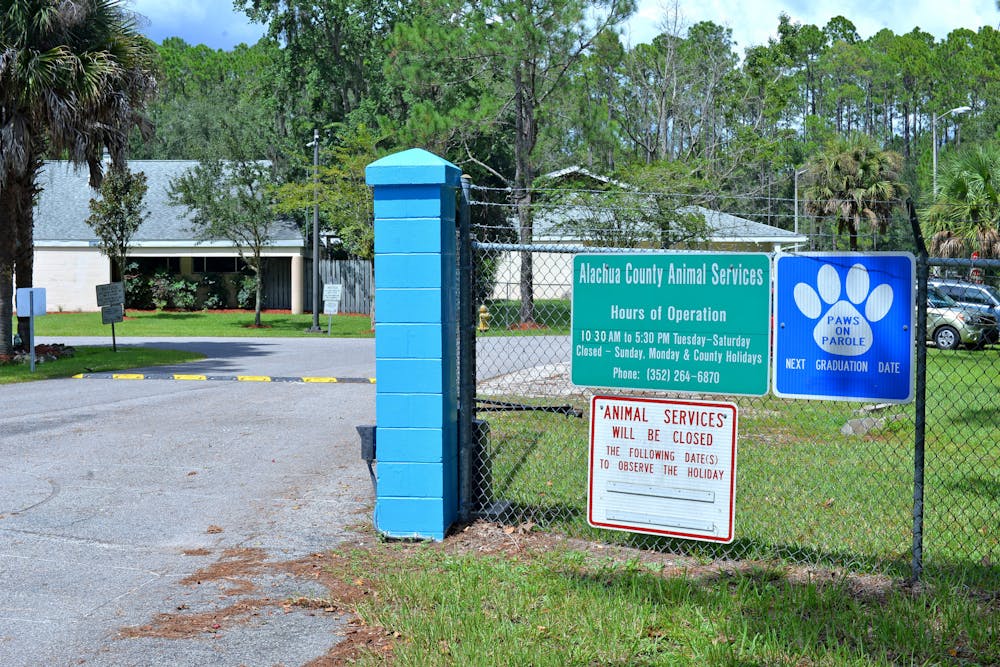Though the Alachua County Animal Resources and Care hasn’t always been a place where animals find their forever homes, the shelter has its own plans to accomplish that goal.
A new AR&C director, Julie Johnson, was confirmed by the Alachua County Commission Sept. 13, and will begin working Sept. 26.
Johnson’s hiring follows a series of issues with the shelter including closure of the facility in June due to extreme overcrowding and mismanagement, staff accusations of the former shelter director Ed Williams’ high euthanization numbers and mistreatment of animals and Williams’ subsequent resignation.
AR&C presented its progress to the County Commission Aug. 23 and have since carefully managed their animal intake. Staffing will be expanded along with the hiring of Johnson.
Johnson is determined to understand the challenges AR&C has faced to ensure changes are made, she said.
“I want to make sure that we’re continually aligning our goals,” Johnson said. “I want to make sure our animals are getting the best care possible every single day.”
Loly Bouchard, a 39-year-old Gainesville resident, said she volunteered at the shelter for many years before Williams let her go.
“The next director not only needs to be an animal person, but a people person — somebody that is open to public concerns,” she said.
Hilary Bynes, a 59-year-old Gainesville resident, worked at AR&C for over 22 years. She’d like to see more of an emphasis put on employee wellbeing from the new shelter director, especially due to the stressful nature of the job, she said.
The shelter left many kennels unsanitized prior to its temporary shutdown of animal intake, she said. These issues occurred during periods of overcrowding and caused severe outbreaks of distemper — a viral disease that affects animals, especially dogs.
“You really have to have good cleaning methods, or you’re going to get disease again,” Bynes said.
The shelter was forced to keep its remaining animals in wire crates as kennels filled. These crowded conditions also increased aggressive behavior, Bynes said.
To address overcrowding, the shelter will implement a managed intake process, meaning it will limit the number of animals that enter the shelter on a daily or weekly basis, shelter supervisor Faren Healey said.
“Owner surrenders are going to be by appointment only,” she said. “And that’s just to assure that we can help these people hopefully keep the animal in their home.”
Carl Smart, deputy county manager of community and strategic initiatives, served as the AR&C interim director before Johnson’s appointment. A seven-day hold period on strays will be put in place when shelter numbers become too high, he said.
If stray dogs are brought to the shelter, they will be examined and vaccinated, Smart said. But the person who retrieved the animal will be asked to hold on to them for seven days in order to manage animal intake.
Because overcrowding has drastically decreased, all crates were removed and more space has been cleared to allow for better sanitation processes, Smart said.
The AR&C facility itself has also undergone a series of beneficial modifications. Canvas has been installed over the outdoor kennels for shade, and something more permanent will be put up soon, he said.
With these changes comes an expansion of the shelter’s staff. AR&C is currently onboarding kennel technicians, animal control officers and investigators, Smart said.
Since its closure, the shelter has led several successful adoption events, including the “Best Friends Event” in July and “Summer Lovin” in August, the latter being partnered with the UF’s Shelter Medicine Program. These efforts drastically reduced the shelter’s resident numbers from 342 to 136 at the time, Smart said.
“That is absolutely a partnership that will continue for the foreseeable future,” Healey said.
AR&C also plans to partner with the Best Friends Animal Society — a national no-kill shelter organization — for most of their upcoming events to make room for more lost animals in the community, she said.
“We’re getting close to capacity already, and we’ve only resumed normal operations for the past few days,” Healey said.
The shelter is working with the County Commission to find a more suitable location because it has nearly outgrown their current space, Smart said.
“We need a larger facility, and we need a facility more up-to-date with technology and equipment,” he said. “That’s kind of a future plan, if you will.”
Contact Rylan DiGiacomo-Rapp at rdigiacomo-rapp@alligator.org. Follow her on Twitter @rylan_digirapp.
Rylan DiGiacomo-Rapp is a third year journalism and environmental science major and the Fall 2024 Enterprise Environmental Reporter. Outside of the newsroom, you can usually find her haunting local music venues.






